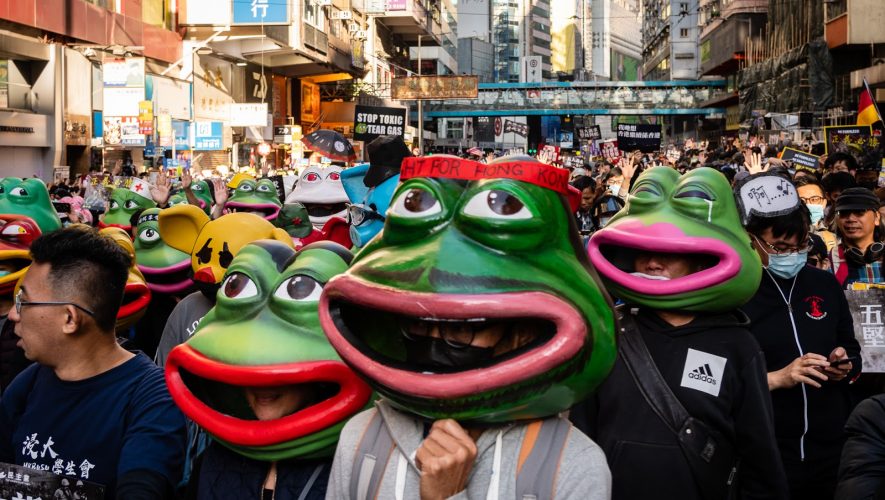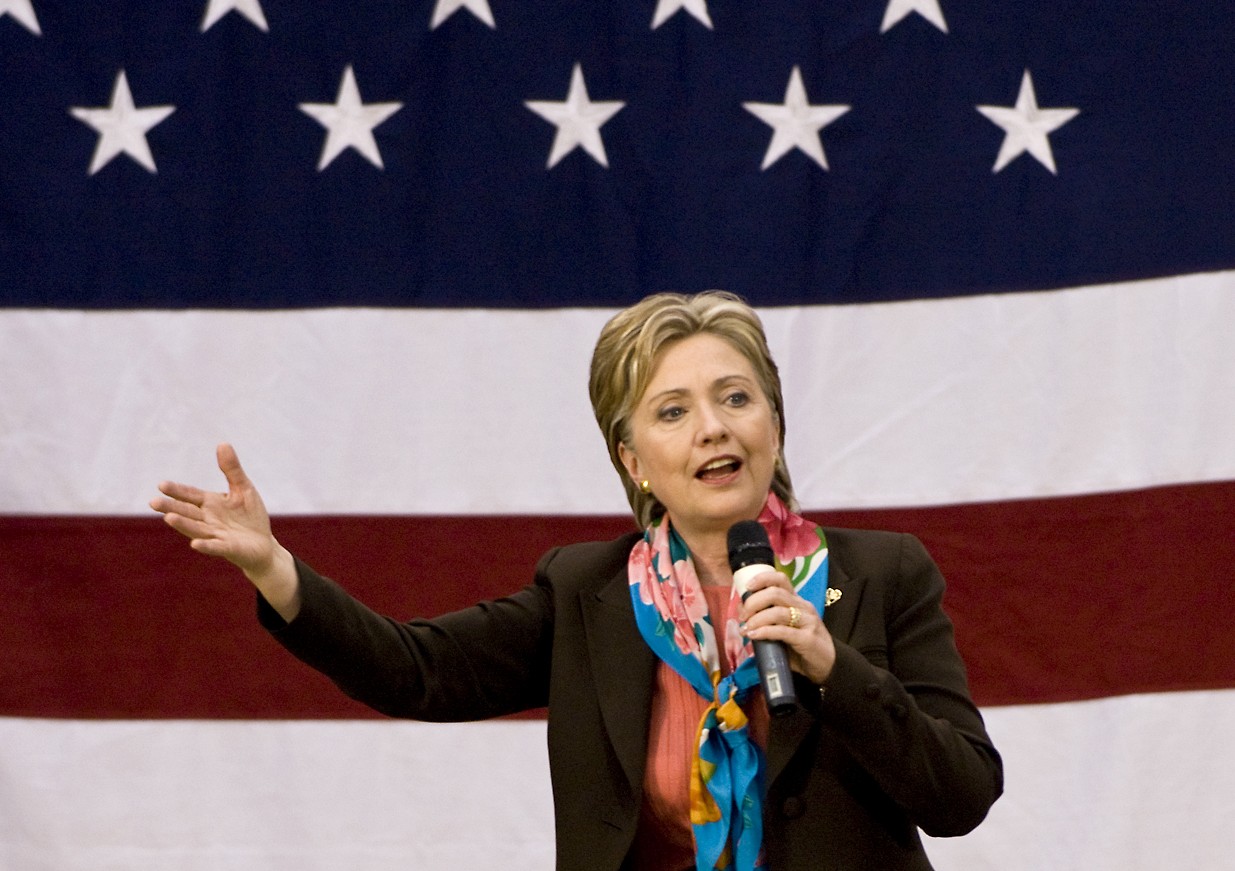Pro-Democracy demonstrators in Hong Kong wear masks depicting Pepe the Frog.
By reflecting and shaping social sentiment, memes have come to symbolize localized social movements, subcultural associations, and political alignments. These recognizable images convey varying sentiment depending on context and—through constantly evolving channels or new media—can be harnessed to heavily influence social and political structures.
Some memes are so intertwined with particular communities that they become emblematic of related movements. Pepe the Frog, once an innocent comic book character, has been so closely tied to the American alt-right that not even his author killing him off in 2017 could expunge this perceived relationship. But that meaning and association can be transformed depending on use; Pepe is now seen in Hong Kong as a symbol of democratic resistance against an authoritarian state.
Similar trends have emerged with the phrase “OK Boomer” and Joaquin Phoenix’s Joker, a character turned meme. People across the political spectrum use “OK Boomer” to mock baby boomers. Meanwhile, incels (involuntarily celibate mysogynists) and pro-democracy protestors around the world use the likeness of the Joker—a frustrated, underdog anarchist—to create versatile political and social commentary. Though the groups use the Joker differently, in both instances these memes manifest in contexts outside of their traditional association.
The versatility of memes calls for a fluid, context-dependent understanding of traditional cultural symbols and emblematic imagery that once had fixed meaning. Largely enabled by context collapse in social media, this new fluidity of social symbols suggests that online communities around the world may be adopting an anti-establishment mentality. Simultaneously, because context matters, the symbols themselves may no longer hold as much weight as the channels in which they are disseminated.
The Power of Memes: A Unit of Cultural Transmission
Context collapse in social media refers to the idea that social network channels nullify social and cultural context, setting a new standard for audience interaction. The unfettered audience of any given media platform can interpret, appropriate, and spread memes, facilitating the evolution of those symbols and their applied meaning as they pass through different groups of people.
Memes hold great power as user-generated content that can speak to and resonate with different populations. Beyond packing humor and social commentary into an easily consumable format, memes are the culmination of socio-political and linguistic drift—valuable tools and vessels of culture.
“Memes allow a person to express a complex cultural message through a minimum of space,” explains Shane Tilton, Associate Professor of Journalism at Ohio Northern University. “The old cliché used to be ‘a picture’s worth a thousand words.’ A well-constructed meme can be ten thousand or a hundred thousand words if the audience understands all the complexity of the messages.”
Memes, an invaluable tool conveying layered meaning, inherently create in-groups and out-groups. Often, only those “in the know” can relate to a meme and the encoded commentary it carries.
“A lot of internet memes work like inside jokes, where it’s really funny to people who get the reference, who understand what you’re talking about, and really befuddling to people who don’t, who find themselves on the outside,” explains Ryan Milner, assistant professor of communications at the College of Charleston and author of the book The World Made Meme. “So you get that element of one, not only sharing experiences, but also two, saying we share this experience that other people don’t share. So there’s a lot of comradery and sociality in that.”
Versatility of “OK Boomer” and Pepe the Frog
Joshua Citarella, adjunct professor at the School of Visual Arts in New York and a researcher specializing in online communities, notes that “OK Boomer” not only speaks to a generational divide within the Democratic party, but also crosses party lines in representation. Although more “zoomers”—the Generation Z foil to baby boomers—skew politically left, many also inhabit spaces on the right, creating space for versatility in memes like “OK Boomer.” Since the phrase can be used in different social contexts, it can represent different sentiments.
“The ‘boomer stuff’ has been going on even before the specific example of ‘OK Boomer,’ and there are different groups that this means a very different thing to,” notes Citarella. “There are left-wing groups that are upset about the decimation of organized labor in the United States and about the austerity of neoliberalism. And they look at the older generation—that they weren’t sufficiently militant to protect the material well-being of younger people and climate change is a big one.” Citarella explains that right-wing kids equally hate the boomers for widely different reasons, such as protecting civil rights and liberties for people of color in the United States.
Citarella also notes that regardless of which cohort uses “OK Boomer” to discredit the legitimacy and authority of those the user considers to have outdated ideals, “they equally hate the older generation.” And understandably so. “OK Boomer” has become a stand-in for social commentary denouncing outdated ideals, however the user defines them.
Pepe the Frog is arguably the most fluid internet meme to grace niche imageboards and mainstream platforms. Originally a peaceful, goofy, anthropomorphic frog, Pepe was declared a hate symbol by the Anti-Defamation League in 2016. Before Pepe was appropriated by white supremacists and neo-Nazis, he started off as a character in Boy’s Club, a 2006 comic book by artist Matt Furie.
“When I was doing it, I was in my early twenties, living in San Francisco, and there was a kind of zine scene going on. So people were self-publishing comics and zines and books and stuff like that,” Furie explains. “I just came up with characters. They reflected a bunch of nonsense from college living and just doing a bunch of knucklehead stuff.”
Furie distinguishes the Pepe of his comic from Pepe the Frog, the online meme and later emblematic, co-opted symbol.
“I didn’t really have an agenda. I made a zine with it first and just made copies and gave it to my friends, and I sold it for like a dollar,” he recalls. “But I think where Pepe came from was [when] I posted [the comic] on Myspace.”
From there, Pepe went through a whole lifespan of use, starting as a widely adopted reaction file on image boards like 4chan. When Pepe hit the mainstream following a Katy Perry tweet in 2014, the users who made him a meme attempted to reclaim Pepe from the “normies” by creating images of the frog committing unethical or immoral acts, now known as the “Poo Poo Pee Pee Pepes.”
“The context collapse, or the feeling that those communities no longer owned Pepe the Frog, kind of incited them to use him in such a way that he would become unappealing to the normies like Katy Perry—which is the origin of the ‘Poo Poo Pee Pee Pepes.’ Which is just the most disgusting images you’ve ever seen,” explains Citarella.
Rather than restoring the meme to its original forum presence in cultural context, however, this shift allowed hate groups to interject and claim him as their own.
“Quickly following that was the first Nazi Pepes where they were attempting to use images that were so unappealing that the normie accounts would never post them,” notes Citarella. “Immediately that became an opportunity for actual far-right groups to swoop in and say ‘yes, we’ve owned this symbol all along, all of the Pepes that have been posted up until this point are people who agree with us.’”
“It was weird, but I kind of just recognized it as the nature of the internet or something,” explains Furie. “It’s just people kind of reinterpreting it or remixing it for their own agenda or whatever. It’s almost like two different versions of Pepe. There’s my Pepe that’s in the comic book, and he’s just a sleepy frog that likes to eat snacks and play video games and stuff. Then there’s Pepe the Frog which took on a life of its own.”
Today that agenda has shifted as demonstrators in Hong Kong and American leftists are actively reclaiming him as a symbol of resistance against the abuse of power.
In Hong Kong, Pepe is emblazoned on protest signs and messages against police brutality and the extradition bill that would grant mainland China’s courts greater authority over Hongkongers and foreign nationals. Sometimes he wears the iconic yellow hard hat, which protects the heads of protesters and represents their unwavering resolve. Other times, he’s just a green frog dude.
Some groups reclaimed Pepe in endorsing transit fare evasion in New York City, as Twitter account Vitalist International posted a photoset of Pepe the Frog hopping a turnstile with the slogan “Hop that shit, Pepe don’t pay #FTP.” The meme was shared across social media to promote the widespread November FTP protests across greater New York City in response to increased police presence on the subway. Some Twitter users accused the group of revealing right-wing sympathies in using the character. Vitalist International denied the accusation, writing, “Pepe is not a symbol of hate.”
Hop that shit #swipeitforward pic.twitter.com/DV870YUSrR
— Vitalist International (@VitalistInt) November 20, 2019
Co-opting The Joker for Democracy
Since 2019, citizens worldwide have taken to the streets in displays of civil disobedience, voicing outrage through mass protest. In Iraq, protests erupted in October in response to widespread unemployment, government corruption, and the denial of basic rights and services. Despite Iraq’s prime minister resigning in November, protests persisted. Joker imagery continues to surface as demonstrators don face paint and masks. Despite the Joker’s association with highly misogynistic, sometimes violent incels, his likeness represents something different to protestors: a symbol for underdog resistance.
In Chile, a spike in metro fares in October 2019 sparked protests across the country. Higher fares reflect rising living costs, which—coupled with stagnant wages and inadequate social rights and services—exacerbated tensions. Chileans were tired of living under plutocracy as class inequality and corruption ran rampant. Despite the president replacing his cabinet, citizens continue to protest police brutality, inadequate public health, and unresolved economic problems. In 2017, the United Nations found Chile to be the most financially unequal country in the Organization for Economic Cooperation and Development, further illustrating the class disparities Chileans live with.
Protesters in Santiago donned Joker makeup and costumes, with one demonstrator suiting up in full Joaquin Phoenix Joker garb and waving a Mapuche flag amid burning wreckage. The flag of the indiginous Mapuche people symbolises a historical stand against Spanish colonial rule and resistance against the economic and social inequality inherited from the dictatorship of Augusto Pinochet––violations that still impact working-class Chileans and indiginous Mapuche peoples today. For Chilean protests, the Joker represents the fight against stark class disparity, inequality, and warfare, and the striking parallel between these demonstrators and the Joker is the subject of many viral resistance images.
In Lebanon, citizens took to the streets in 2019 in response to a proposed tax on internet cell phone app calls such as those made on WhatsApp. The so-called “October Revolution” materialized, as citizens across the country’s deep socio-economic divide came together to protest Lebanon’s financial crisis and its political elite. Not even the prime minister’s resignation could quell the resistance, as demonstrators returned to the streets in April due to worsening economic conditions. As with other countries experiencing mass protest, the Joker appeared in crowds in the form of masks and face paint. As protesters occupied public spaces across Beirut, widespread use of Joker imagery enforced the reclamation of the city by the people in a powerful display of resistance.
Even in Hong Kong, demonstrators donned Joker face paint and masks, protesting a ban on face coverings during public gatherings—a policy still in effect despite the coronavirus pandemic.
The media would've never predicted that the Joker would become an icon for civil protest against tyranny, disenfranchisement, and inequality. Here's Beirut, Hong Kong, and Chile. pic.twitter.com/82OynUC3R3
— Ian Miles Cheong (@stillgray) January 28, 2020
In all of these places, as well as Bolivia, Spain, and France, pro-democracy, anti-government demonstrators adopted the Joker for widespread displays of civil disobedience. But why are leftist protestors using the Joker to stand up to the abuse of power around the world?
Context.
“The Joker appear[ed] in Chile and Lebanon, and Pepe appear[ed] in Hong Kong. And I think the only real way to make sense of this is to revert back to the idea that meaning is contextually specific, and what something means in one in-group, it does not mean in another in-group,” explains Citarella. “So if you were to visit /pol/ (4chan’s political[ly incorrect] discussion boards), you would find the racist Pepes. But if you were to visit another group, you would find Pepe meaning very different things.”
Pepe was not always an emblem of the alt-right; he was just appropriated as one. Ultimately, the anthropomorphic frog guy resonates with many, letting this “everyman” figure represent populist movements around the world. Similarly, the Joker is attractive to political protesters and aggrieved white dudes on 4chan because he’s a lonely, resentful anarchist who struggles in a world defined by a class war.
There are elements in these characters that many people sympathize with. The notion of a poor, rejected white guy “breaking free” by killing three successful Wall Street types (among others) fits into the “why me” framework of incels. On the other hand, the notion of a struggle between the proletariat and the elite resonates with protesters in Lebanon and Chile. Protestors use Joker imagery to represent their anti-establishment views in the face of government corruption and neglect.
Structural Channels: The Fluidity of Memetic Imagery
Beyond the flexibility of imagery, Citarella notes the importance of understanding the “feedback loop” the media creates when propagating images as the symbol of a particular social movement. The extent of its use is hard to determine because striking images are more likely to go viral—is an image universally accepted by those engaged in a movement or just an appealing shot?
“There are so many layers on top of it. Of what just happens in the in-group, what happens on social media, and then what happens in the media. Then, it kind of creates this feedback loop,” Citarella explains. “There is, of course, some degree that the protesters in Hong Kong have seen the way that Pepe is used in the US.
“That person in Chile or that person in Lebanon was aware of the [Joker] photo [of protests] elsewhere . . . those individuals are certainly aware of each other. The degree to which they are emblematic or indicative of a mass movement organized around that symbol—my inclination is that [it] is just one person in a crowd of one hundred thousand, and it is disproportionately amplified through the media.”
November 16, Yellow Vest protest in Paris (France) from joker
Subculture, meaning, and context are intrinsically tied to platforms. The content that exists on image boards like 4chan differs dramatically from the memes you send to your mom on Facebook because the intensity of the political message is shaped and enabled by the anonymity a platform gives its users. In turn, memetic imagery becomes fluid based on spatial context. One must be “in the know” to understand the underlying message—only then can a meme effectively spread and evolve in the hands of the user.
In the end, all elements bring us back to context.
“The question that kind of throws all of this up in the air is the context collapse of social media,” explains Citarella. “The thing that we are really trying to map is kind of a technical question of social media, because we know the social aspect where the symbol only has meaning to the specific context of the group that it’s disseminated in.”
In the age of social media, the notion that symbols are fixed is rendered void. Memes serve as a vessel for social commentary and culture, while channels for communication act as a surrogate for social movements.
“The memes are symbols,” explains Milner. “They’re kind of empty vessels in the sense that people put into them what they see in them, and how people understand them is really what matters . . . There is some kind of cultural artifact, some kind of content, some kind of text, some kind of whatever. And that resonates with people, and then they spread it, and, as they spread it, new people make it their own.”
The adoption or appropriation of memes by different groups can package complex narratives in easily digestible formats, heavily influencing socio-political outlooks and engagement. These internet-made symbols convey complex social commentary—and the representative imagery associated with a particular movement—using minimal space.
Like with any social commentary, context is key to understanding the core of a message, but communication channels influence the message from a structural perspective. The medium, largely, is the message. Content, subculture, and technological base are intrinsically tied, as platforms greatly determine what types of content can exist and flourish in each space.
Our social sphere is defined by a lack of separation between online and offline culture. Memes have far-reaching implications for socio-political structure, as recognizable images replace words on protest signs and one-word utterances replace paragraphs of text without losing that complex and layered meaning to the in-group. They’re fun, they’re funny, but memes are also widely powerful.
New fluidity in the age of social media is key to understanding the ever-changing chain of social and political movement and progression. While symbols were once localized to groups, movements, and ideologies, today those symbols—in the form of memes—constantly evolve with the cultural spaces that carry them.



